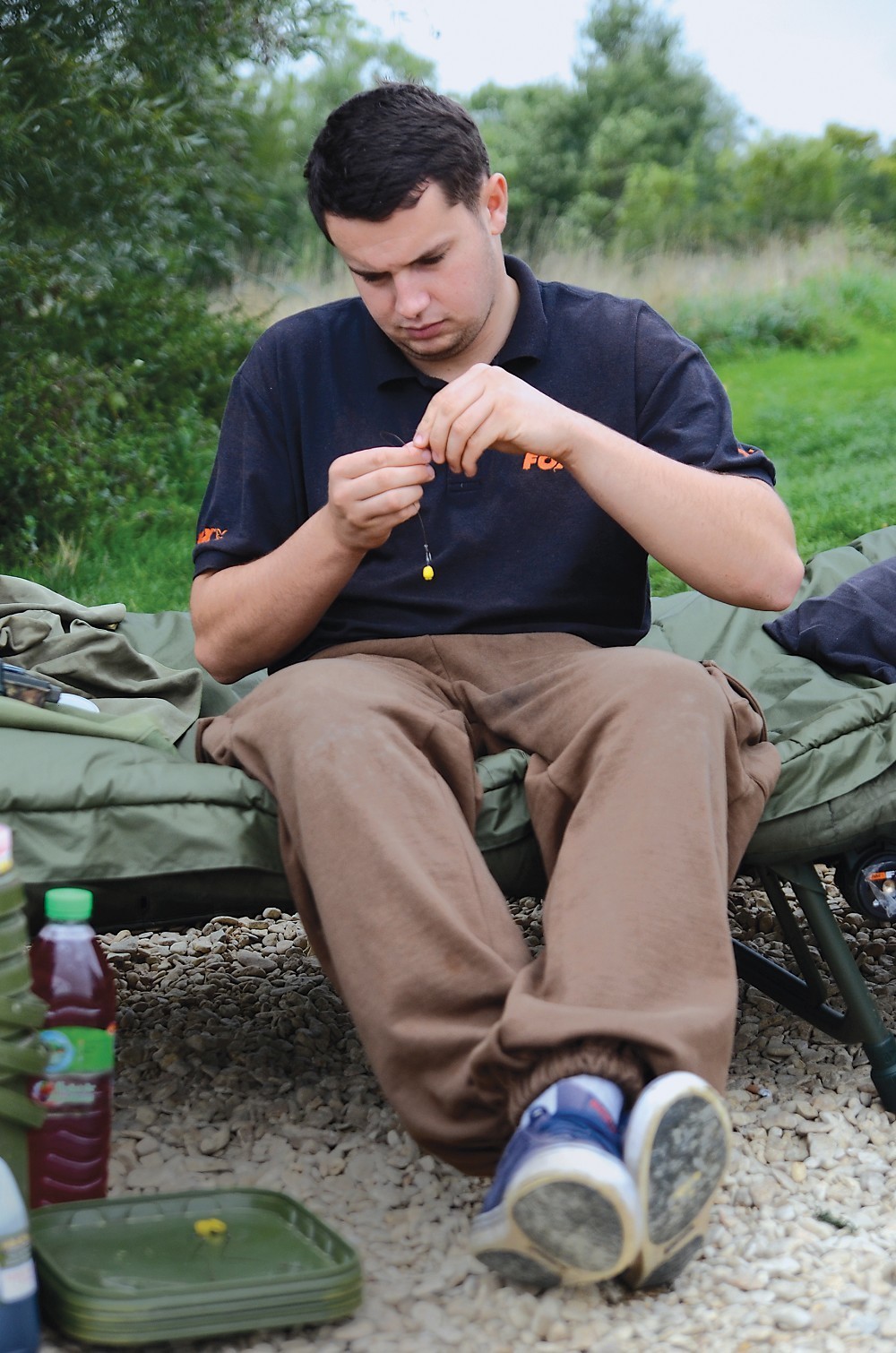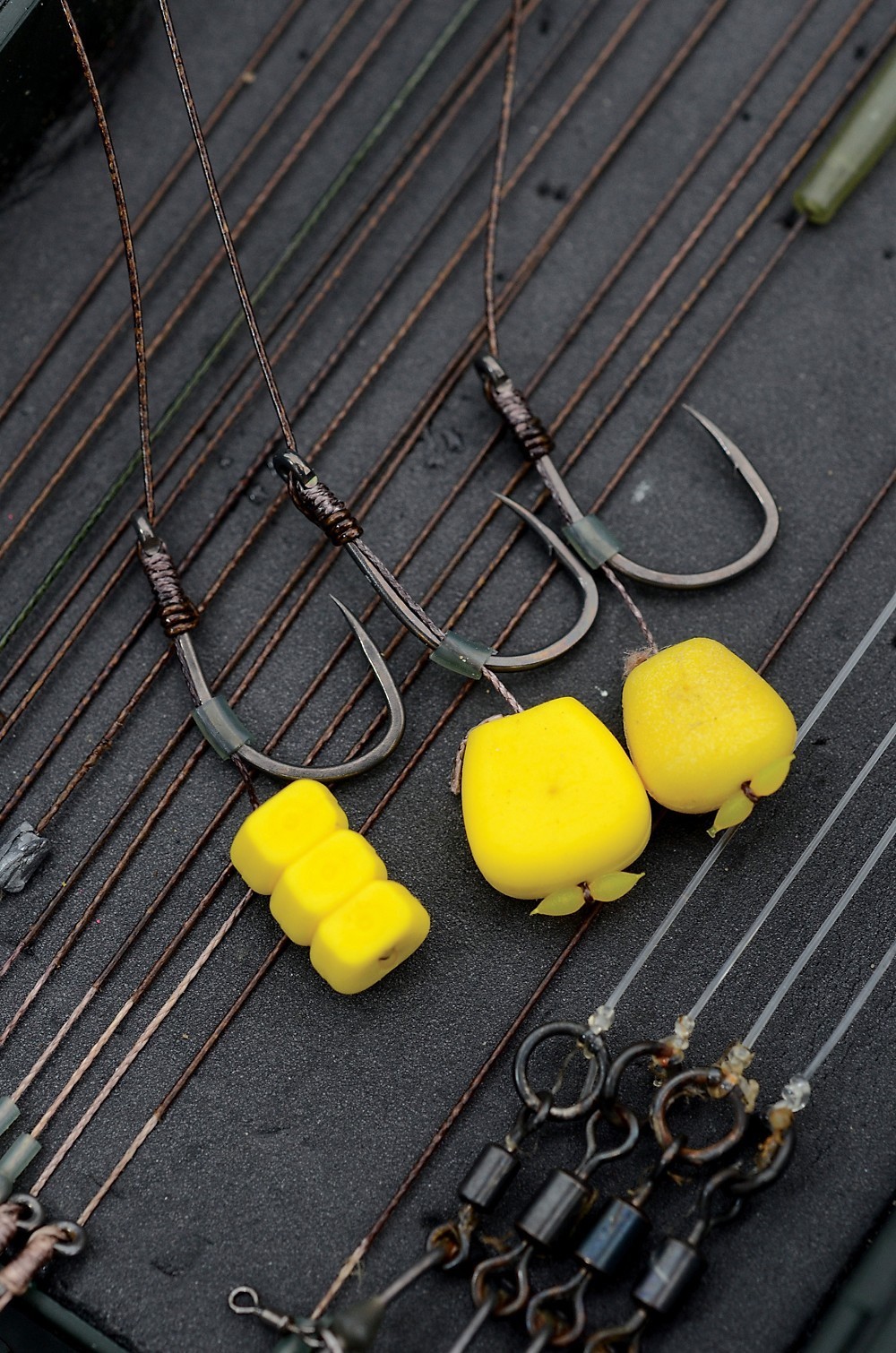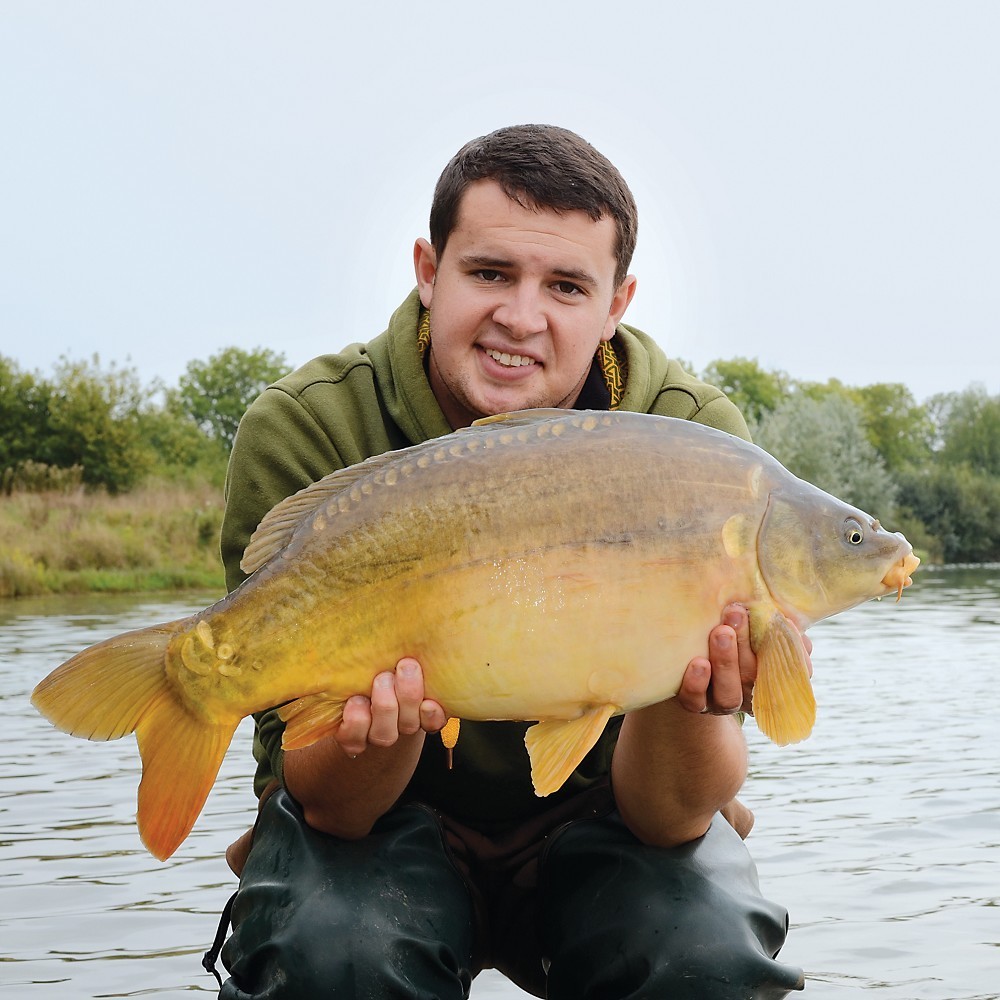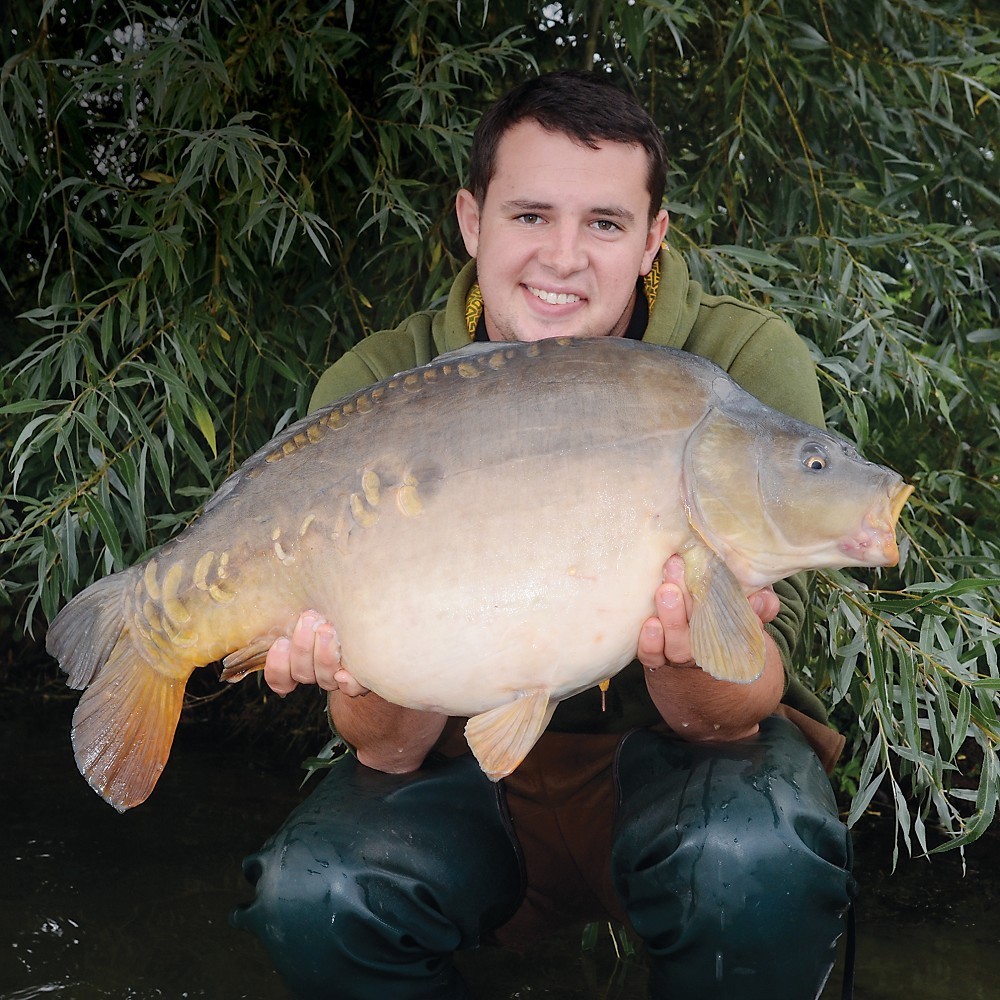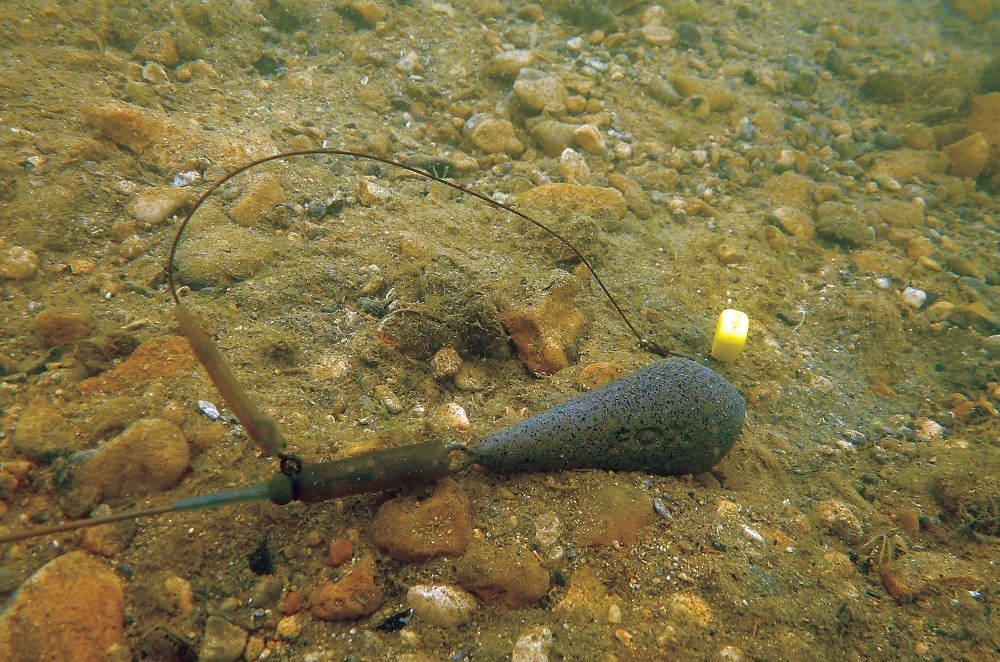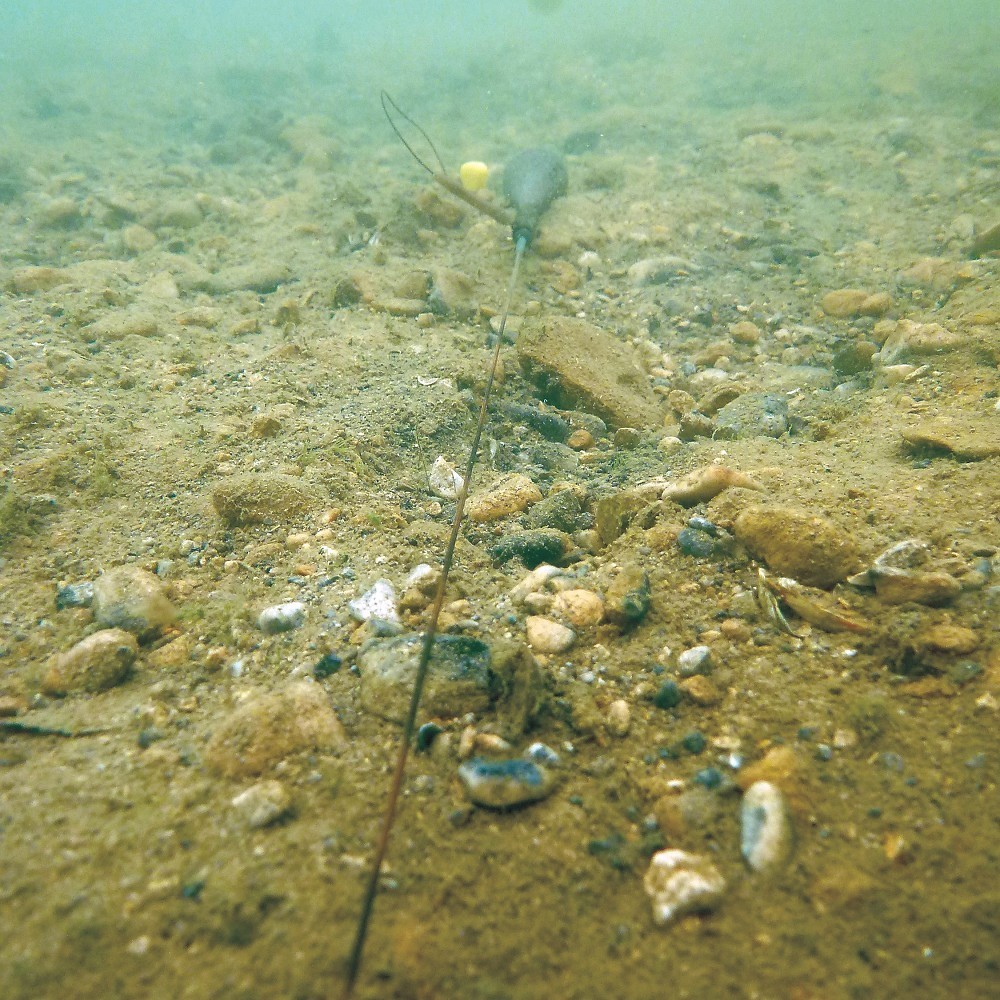Below the Surface: Tom Maker
Is Tom Maker, an all-round carp-catching expert, about to make history and reveal some bait-related hidden truths? We'll spoil it and tell you he is...
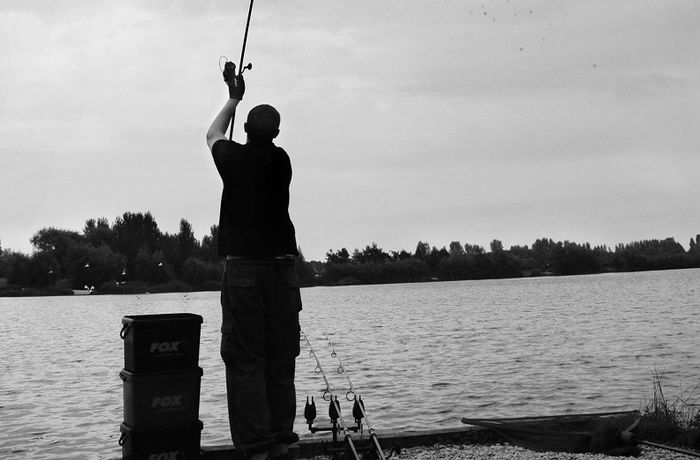
Nowadays, “named” carp anglers tend to be put into different categories: the ‘big fish’ angler; a ‘match style’ angler; a ‘European specialist’; a ‘day ticket expert’; a ‘weekend pro’. This isn’t so with Tom Maker. 240+ thirty-pounders and 11 UK forties up to 44lb 8oz suggests he’s a ‘big fish’ angler. He made three finals out of four in the British Young Carpers’ Angling Championships and making it to the final on four occasions out of four in the adult version of this carp match would indicate he is pretty handy when it comes to this style of angling. He’s also had fish to 56lb 4oz from France, fished mostly day ticket venues for most of his life and thanks to previously working five days a week combined with the above successes would suggest he’s a ‘weekend pro’.
Yep, that’s right. Tom Maker is something very special. But we knew that before Hughesy had even dropped through the water layers and down to his baited spot as young Tom has previously been featured in Below The Surface. Back in November 2011 we tested him over at Abbey Lakes and yes, he did exceptionally well. He read the swim perfectly, the line lay was pinned flat and out-of-sight and his presentation was cock-on. We thought that was that, but then, on a chance meeting whilst shooting a feature for our sister title, Maximum Carp, we bumped into Tom and his client, Neil, who were fishing from The Point on Linear Fisheries Brasenose 2 (B2). What we witnessed was a combination of utter mayhem and amazing skill. We’re not talking double takes, we’re talking triple takes. On his first day, from 3pm to 8pm Tom had 16 bites. The next day he followed this up with another 33 and by the next afternoon he finished with 62 fish in total, including 12 twenties and a 32lb mirror. Even more impressive was Neil, the chap who was on a tutorial with Tom also bagged 40 odd carp.
So, as you can imagine, we just had to arrange a re-shoot, back in that swim, with Tom working it in exactly the same fashion. This could be our opportunity to (a) get some truly epic images and (b) finally find out how much and how quickly the carp in these types of prolific day ticket waters can clear a baited spot.
Oh, and we almost forgot to mention: Tom didn’t fish the nights on that session… Mind-blowing, eh?!
Effortless
Watching Tom spod out his mix is like watching poetry in motion. He almost makes the 100+-yard cast look effortless, and even more impressive is the fact he’s landing each one on his chosen spot with total precision. Of course he’s well practised at this and in particular the feature he’s baiting up to, which Tom informs me is around 5.5ft deep and will now just be down to clean gravel.
“I really can’t imagine there’s anything left on it – I’d say it will look like polished gravel. In terms of its size, I think it’s a longer spot rather than wide: a 10 x 2yd rectangle.”
Tom’s well trained when it comes to landing three rigs on a dustbin lid – he’s been doing it for years and today he hasn’t let us down: his three main lines are running perfectly parallel to one another with no more than six-inches between each one. Achieving that at 50yds would be hard, but at 100yds? It almost seems impossible.
“I suppose because I’ve done it for so many years I can just naturally do it now,” says the likeable young lad. “But in terms of how I actually do it, well, I pick an obvious marker on the far bank and instead of breaking itup into three – i.e. a left-hand side, the middle and the right-hand side, I actually just aim at the same part of the tree on all three casts and if one of the rods goes slightly left or right I just move them across accordingly.”
My next question was of course obvious: although they look like they should be super tight at the rig end by the way the lines come off the tip rings, how tight does Tom predict they will actually be?
“I reckon you’ve got about 8 to 10ft between each rig, so there’s quite a bit of space between each one but then there’s a lot of fish in here so I don’t want them too close together. I want them in an area competing rather than on one spot.”
Although Tom’s mix is slightly different to the one he used during that mental session just prior to today’s “test”, the way he’s baiting the area is the same, which, according to Tom is, “the key to success on these types of venue: baiting little and often”. So far he’s put out just 10 spods which he informs me is standard for him and then he follows this up with three more spods after each fish, or, if he’s not had a bite within an hour he’ll put out another five.
“Baiting is where so many people get it wrong and it can make or break your session. Everyone turns up with a load of bait and feels as though they’ve got to put it all in at the start. You don’t and you shouldn’t. I know it’s an old cliché but the phrase, ‘Once you’ve put it in, you can’t take it out’ is so true. Start light but then be consistent with regularly baiting.”
On his previous session, Tom was using a mixture of hemp, corn, crushed tiger nuts and a few pellets, but this time he’s trialling a new product called Tiger Nut Chippings, and to that he adds nothing more than sweetcorn. The obvious question is ‘why switch’ and Tom’s reply is simple: “I just wanted to try something different!” But according to Tom the main ingredient isn’t those new form of tiger nuts, but that all-time-but-often-forgotten classic: sweetcorn. “It really does seem to switch them on and it appears the more you use, the more they love it,” he tells me.
Just like this bait choice, Tom’s rig choice is something different to the norm too: size 4’s fished with either
a single or three pieces of fake corn…
“I’m using size 4 SR's on all three rigs, which is a pattern of hook that has been designed for Chod Rigs so they feature an out-turned eye which means more of the hook’s gape is open. Two of the rigs have single grains of plastic corn on and the other has three little pieces of fake corn. I’ve set them up like that, not because I think it makes any difference, but just to chop and change things around. In terms of the lead arrangements, I’m also mixing things up there, fishing two helicopter style and the other on a lead clip and this is purely to see how they look out there. And I’ll just add that I’ve had equal amounts of takes on both, so I don’t think it makes that much difference.”
Like you right now, I too was a little surprised to see such a big hook with such a small and nimble hookbait, after all, every article, web blog and free DVD tells us to “match the hook size to hookbait” – Tom’s clearly a maverick!
“I just don’t think it makes any difference to the number of takes I receive, and with a bigger hook I have a much higher chance of landing it. At the end of the day, if you opened up a size 10 and a size 4, the difference in metal would be what, two or three millimetres? In my mind it’s not enough to make a difference. They’re not shiny hooks either; they’re Teflon coated so they’re well concealed.
Along with developing the art of spodding over Zigs, Tom’s a bit of a specialist when it comes to fishing solid PVA bags – a tactic which I was expecting to see him implementing right now.
“The spot is obvious enough as it is and the bait I’m putting out will split and spread as it falls through the water so I want my hookbaits to be sitting like the free bait, whereas if you’ve got three little lumps of pellets it can look a lot more suspicious than three grains of corn would. Plus, with the end tackle components we have these days, they don’t tangle, even with light single hookbaits on so you’re always fishing.”
Well, we’ll find out if that’s the case shortly when I hand over to our esteemed diving pro, Rob Hughes, but how does Tom think those three rigs will be laying?
“I’m sure I will be shocked! But to be honest I don’t think it really matters how the rig sits, it’s how you feed; how you build the carp’s confidence. I’ve got no putty on the rigs which are only about four- or five-inches long so in theory they should be laying flat, but when they’re travelling over 100yds and at God knows what speed, anything could happen to it. But, like I said, it’s how you feed the area which is the important part. As long as you can get those fish competing I don’t think your rig presentation matters too much.”
Another key area where Tom differs to both what the media tend to say and what you see 90% of other anglers doing, is how he fishes his lines.
“Always tight,” he confidently tells me. “Because I’m fishing over gravel, weed and on these big lakes the water’s never still so your main line doesn’t go off the rod tip and follow the contours of the lakebed – that just doesn’t and won’t happen – so by fishing it tight it means that anything that happens at the rig end I will know about it instantly. And although I’m fishing very tight lines, I’m still confident my leadcore leaders will be flat to the lakebed. It’s only 5.5ft deep anyway so I would say the leadcore will be flat and I’ve got fluorocarbon leaders on too so I think they will be pretty invisible.
As Tom just pointed out, by fishing his lines so tight means his bite indication should be very impressive. “I reckon he’ll be able to move a little bit, as with 100yds of mono there’s quite a bit of stretch in that, but I fish with springer arms which are designed for tight line fishing so as soon as they move I know it’s a take and I’m on it straightaway. So to answer your question, maybe 3 or 4ft before I get a bleep.”
And now I will hand over to Hughesy who will tell us how close all Tom’s predictions really are…
Really, it was purely chance that we decided to ‘re-do’ Tom Maker in this series. He did feature for us in BTS a couple of years ago and a sterling job he did too, but the format has now changed with a bit more emphasis on catching fish and also allowing anglers a bit more time to do their job. It also gives us a little more time to investigate what is going on and pass that info to you guys.
Whilst up at Brasenose 2 on a recent feature, I had the pleasure and the privilege of being pegged a couple of swims down from young Maker whilst he was on one of his tutorials. It was, quite frankly, ridiculous. Buzzers were going off all the time with double and even treble takes, and Neil, (the guy that was with him), had the session of his life. In fact, I bumped into him (Neil) again a week or so later at the same venue where he was back to put what he’d learned from Tom into action. He bagged 40 odd fish in a couple of days.
Having seen the performance, Joe and I discussed that we should feature Tom again. He was on fire, especially on B2 and to go out and see a swim rocking in the way that he had it going would be epic for this series. Brasenose 2 fish can be a bit spooky, but when they get their heads down they are crazy feeders and one of the things we always like to get in BTS is a ‘before and after’ shot of the swim when fish have fed. We’ve had the odd bite in the past in this series, but never a ‘smash up’ and we reckoned if anyone could, Master Maker could. The big question was could Tom re-create that sort of fishing for us?
No fuss: Just solid angling
In a perfect world we would have had roped off swims, pre-baited areas and days and days to do the shoot, but that’s not how we roll at Ology. It’s real, it’s raw and sometimes it’s a disaster, but it is what it is and you get to see the truth. However, on this occasion we deviated from our normal set-up and asked Roy Parsons to save the very same Point Swim for us as we know the water is clear and a reasonable depth off there and this was the scene of Tom’s smash up. That was the good news as far as Tom was concerned. The bad news was that we only had one day to shoot the feature… and we didn’t arrive until 11… and had to be off by 5… so really we only had 5hrs of fishing time. Game on!
Tom’s a no-nonsense angler and I like that. Simple rigs, steady tactics and no fuss. We got him angling first and it really was no fuss at all. The gear came out of the van where it lives on the barrow and he trotted off to the swim, getting the rods out in a flash. Bang, bang, bang, three similar rigs to three spots in the same area then a few spods of corn and chopped nuts over the top. Sorted.
Within 30 minutes, and before I had even had a chance to get in to the water, one of Tom’s rods rattled off and a mid-double mirror opened the score. This was actually a little bit faster than we had hoped as we wanted to see the baited area from scratch but we were on track and it was better that we get runs than blank.
Kitted up, I swam off to the spot which was a fair way out it has to be said. Upon arrival I could see a number of “spod drops” as I call them. The spod releases its bait in a very different way and it’s fair to say that you can get very different application with different baits and also the way you allow it to hit the water surface.
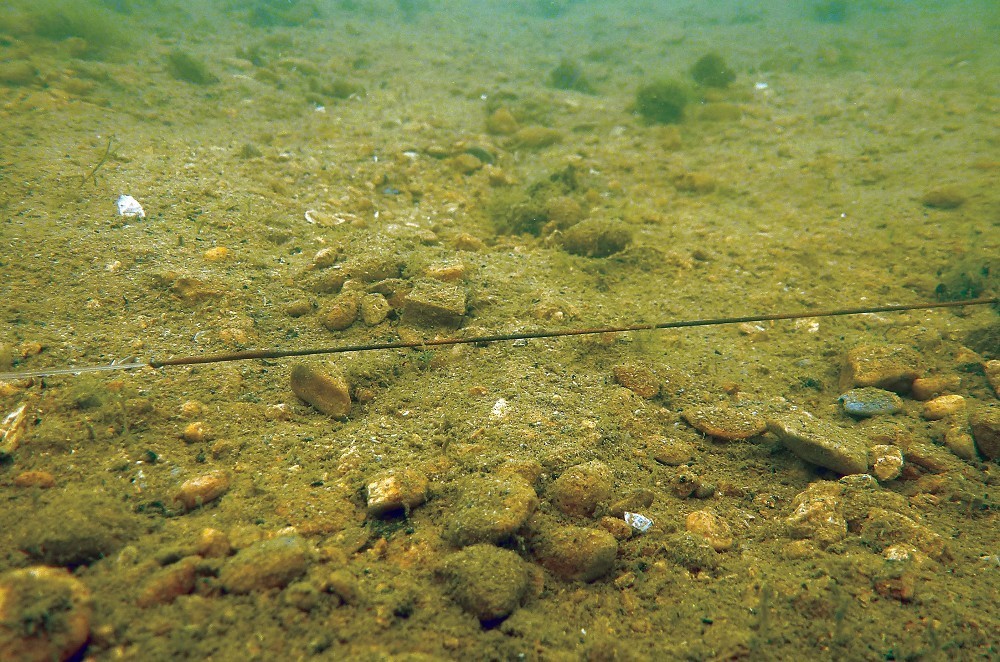 Bowstring tight at 108yds. The 3ft ready-tied leadcore leader is literally only an inch or so off the bottom
Bowstring tight at 108yds. The 3ft ready-tied leadcore leader is literally only an inch or so off the bottomTom dropped half-a-dozen pretty accurately with some hitting the water full pelt and others hitting the clip and dropping softly to the water. This is where the first tip comes in as spod work, or should we say, “good spod work” requires some attention to detail. When the spod bashes down hard onto the water it often ‘bounces’ separating the heavier baits from the lighter baits as you can see from one of the shots. Hitting the clip too hard at the moment the spod hits the water can have a similar effect. However, when the spod hits the water on a slow drop having hit the clip first it usually dumps everything in a pile thus giving a tighter baiting pattern.
There were a few dumps of bait in the general vicinity covering an area about 10ft by 20ft in area, some separated, others tight mixed clumps. The first rod was about a metre behind the baited spot sitting on its own. The bottom in the area was gravel and I could see that the fish had been feeding quite heavily here in the recent past. Tom was actually fishing the exact same place that he had been the previous week when we had seen his tutorial success so the bottom of the lake had probably been cleared off by his feeding during that time and this is a great example of seeing how a spot can be worked over time to be cleared by the fish. We saw it at Linch Hill as well and it’s one of the ways hot spots are created as more and more bait is piled into one area and the fish clear off the silt.
Diving in freshwater lakes so much really allows me to track what the carp are doing and one of these days I really will have to put together into a film some of the footage I have taken whilst diving. Take this spot as a prime example. The bottom of Brasenose 2 is gravelly in this area, but there is still a covering of silt over the top. In places this can be a couple of inches thick and in others a simple dusting. However, when you put angler’s baits and carp into the equation it’s possible to see exactly where they have been feeding and in some places even how they have been feeding. This spot was a prime example of this. The silt had been shifted off the gravel so it was almost cleaned. Just a metre or two to the side the gravel it still had its covering and the difference was purely down to feeding fish and anglers baits. Bear this in mind if you have silt in your lake. You can actually get the fish to move it for you if you have the right bait and apply it in the right way.
Back to Tom’s rigs and the first one allows us to answer a regularly asked question very easily: do tight lines spook carp at the rig end? You can decide from the pics. He was fishing at 27 wraps (108yds) on a tight line in 5-6ft of water. Using a ready-tied off-the-shelf leadcore leader of 3ft long, the end of the leader was only about an inch off the bottom. For me the presentation wasn’t affected by the fact he was fishing tight and the reality is that the difference between the two would be very hard to spot.
The rig was slightly looped, but before the dive Tom had said he thought it would be. I’ve had this conversation with him a few times as he doesn’t use putty on his rigs. I like to, just to nail everything down, but he prefers not to. His catch-rate doesn’t seem to be affected too much so each to their own I suppose.
Rig two was bang-on the bait, very similar to the first but this time with three grains of corn popped up off the shank of the size 4 SSBP ArmaPoint hook. I am biased here, as this is how I like to fish, i.e. with big hooks and a 4 or 5 is perfect for UK fishing. Very occasionally I will drop down to a size 6 for winter fishing but you can keep all of that rubbish about 8’s and 10’s. The three baits sat beautifully and although there was a slight twist of the hooklink around the leadcore, it still allowed the bait to present itself properly. Would it affect the indication? Time would tell.
With the baited area plotted, the rigs photographed and a fish already in the bag, it was time to get out and see if he could pull it off again having had me buzzing round his spot.
'How much has gone?'
Out on the bank and things went quiet for an hour, almost certainly as a result of my presence over the area. However, B2 fish are hungry creatures and they knew there was food around so when the coast was clear they would come back. To encourage this, Tom topped up the spot with another three spods of bait so in total there were now 11 spod loads of corn and chopped nuts out there. The B2 fish are definite sound feeders and the sound of the disturbance on the water often gees them up a bit. Tom also decided to re-cast the looped rig, as once again a re-cast can often bring a bite, and low and behold within 30 minutes one of the rods rattled off. The fish were back!
Now then, this would be interesting. How much bait had they eaten? We knew that 11 spods had been put in throughout the course of the day and that some had been eaten by the earlier fish. When I got out there it was clear that a small group of fish had recently come into the area and had fed on the bait. The area of water around the baited spot was slightly cloudier than the water on the approach and was a bit like a foggy patch when you are driving. Interestingly a few of the spod drops had been almost completely eaten and the carp definitely preferred the corn to the nuts. I could see what I reckoned were three untouched spod loads and the rest were either gone completely or had been partially munched or disturbed. Where there was corn and nuts previously, there was now evidence of only the odd bit of nut where the fish had been through the spot hoovering up the bits of corn and either spitting the nuts out or washing them away with the movement of their fins.
On one of the more dense areas of bait it was possible to see where the fish had moved through the patch like a hoover and had sucked up all the bait in its path. I’ve watched them doing this on beds of corn at Orchid Lakes very regularly where they will simply just cruise slowly over a bed of bait and hoover up anything in their path creating a clear channel in the bait. They don’t really deviate or pick at pieces, they move steadily forwards and scoff anything in their way. The water displaced by their gills puffing out the bits they don’t want and also by their pecs which they use to propel themselves forward, washes away the baits either side and creates a clear pathway just like the one you can see here. This shows just how quickly one fish can demolish and area of bait, and if they are feeding heavily, you need to keep that bait going in.
I wanted to know why, when there had been fish in the area, that Tom’s other rod hadn’t rattled off. The fish had been feeding in the area and you can see by the dust that had settled on the rig that they had been pretty close. Maybe it was because the bait was slightly off the main bed of grub? Maybe it was because the hooklink was slightly looped? Or maybe it was simply down to the fact that they hadn’t had the chance, because straight after the bite I got myself back out into the water to assess the damage that the carp had done to the swim. It looked good, it simply just hadn’t been picked up yet.
The final test is of course indication, and where we have had slack lines and semi-slack lines in the last couple of tests, this time we now have bowstring tight ones fished with a springer. Picking the rig up and moving away it was the by now almost regularity elbow to finger and then a bit before I felt resistance at the rig end. Some lines mean that this distance is shortened and some set-ups mean that this distance is lengthened, but on the whole it was about the same as most other set-ups. This surprised me as I thought it would be slightly better than it was. However, Tom fishes tight lines with a locked up or very tight clutch and this immediately restricts the indication as more than a single bleep requires the line to be stretched. Why does he fish like this? Well, in my humble but pretty experienced opinion, although the amount of indication is reduced, a single bleep is usually enough to tell you what the scores are at the rig end, and fishing with a tight line means that if the fish picks the bait up and tries to move off with it there isn’t a lot it can do to spit it out. The tight line immediately gives the fish a problem and it means it’s less likely to get away with it should it pick the bait up in the first place.
So that was it for the Boy Wonder! He ended up with four fish in 5hrs, showed us that you don’t need to spend shedloads on bait to have a really good day’s fishing, and proved that no fuss angling, good old fashioned watercraft, correct bait application and decent accuracy means that you will increase your chances considerably. Forget fashion and fads, just go angling!
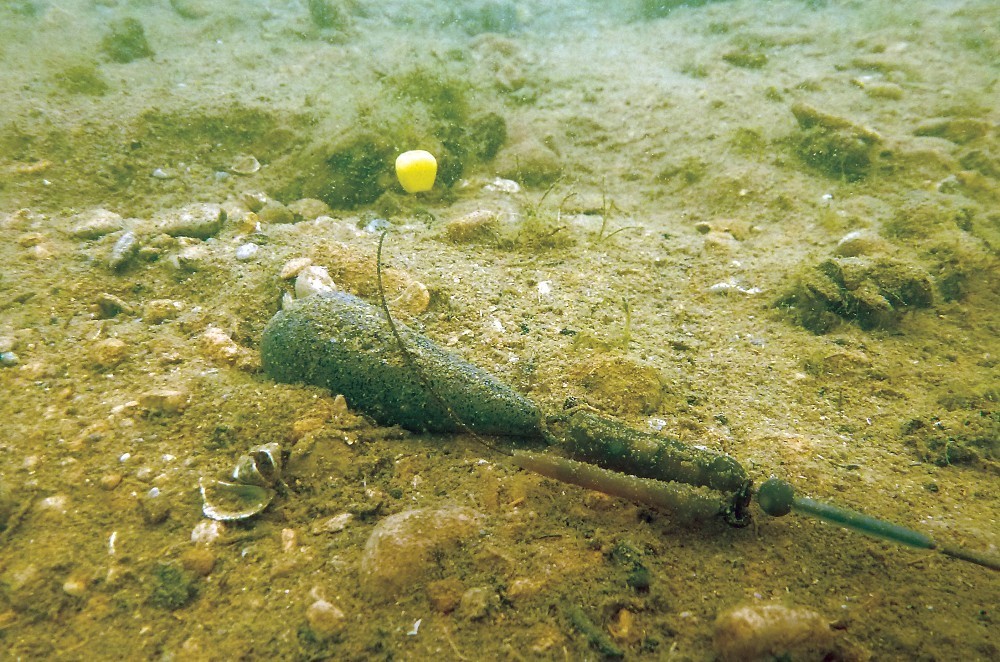 After the bite: You can see from the dusting on the lead and line they have been feeding nearby but there was no pick-up on this one
After the bite: You can see from the dusting on the lead and line they have been feeding nearby but there was no pick-up on this oneWhat he learned...
Highlight? “Just seeing what everything looks like really. I had a slight inkling to how it would be and
to be fair I wasn’t too far off. What today does prove is recasting can be essential. One of the rigs had a bit of a loop in it so I decided to recast it and although that rod didn’t go off, the one which was originally presented well did and if it wasn’t for Rob I wouldn’t have know about the loop, so recasting all the time is good practice in my eyes.”
Lowlight? “Probably that we didn’t catch as many as I hoped we would. I also thought they’d have eaten more bait too; I was quite shocked by that. I learnt a lot so there wasn’t really any disappointments.”
Biggest lesson? “Definitely recasting. I do it anyway because of the type of fishing I do most regularly, but just because your lead has landed with a good drop doesn’t mean the rig is sitting perfectly, so recasting puts odds in your favour. Learning from today’s feature, there are of course things you can do: the rig with three pieces of corn presented better over the other two rigs because it was more critically-balanced so that’s worth noting. But overall, the whole experience has been excellent.”
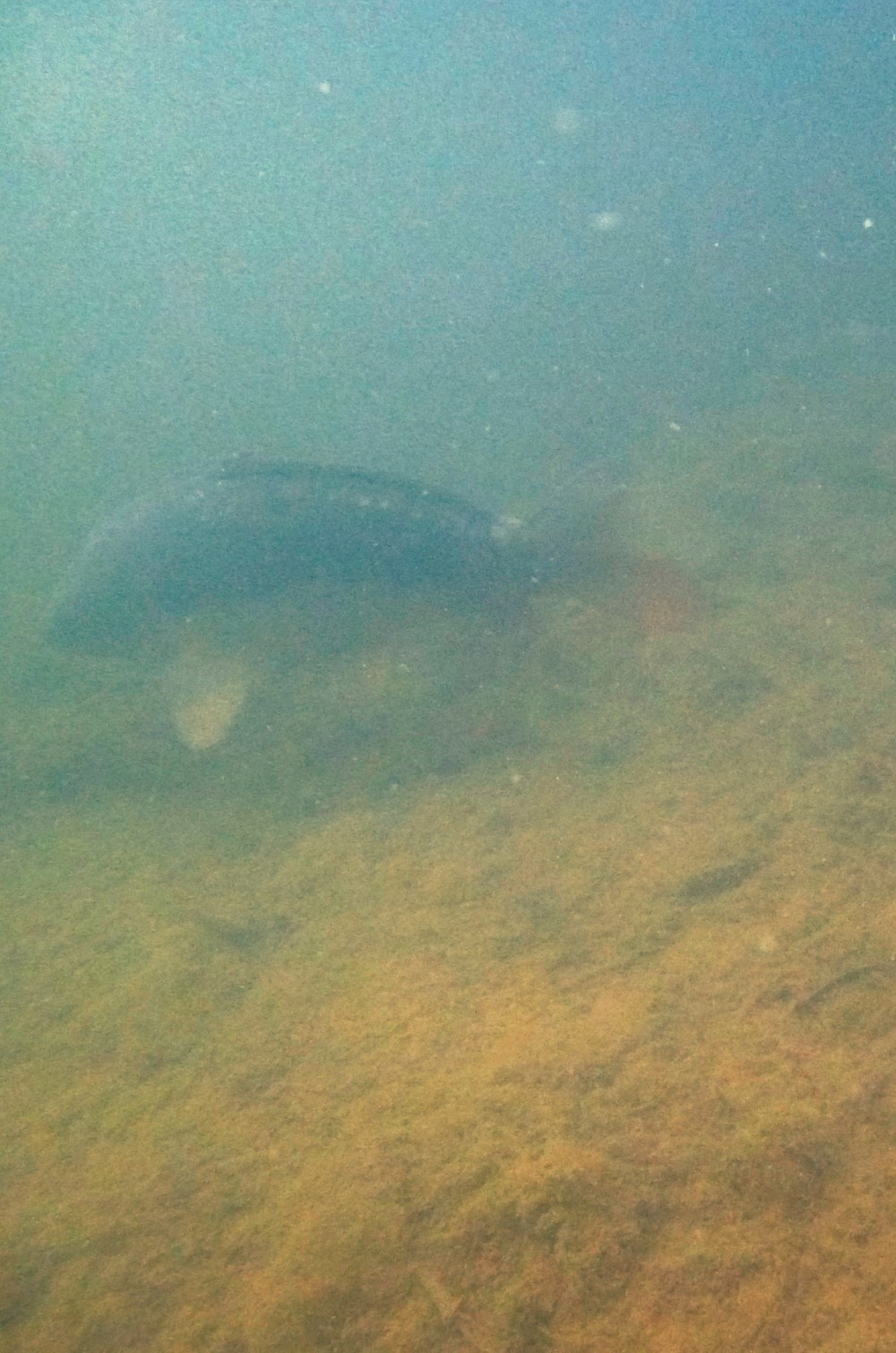 After the bite: They were definitely in the area. The water had a foggy feel to it as the silt and dust was disturbed due to fish feeding
After the bite: They were definitely in the area. The water had a foggy feel to it as the silt and dust was disturbed due to fish feeding


